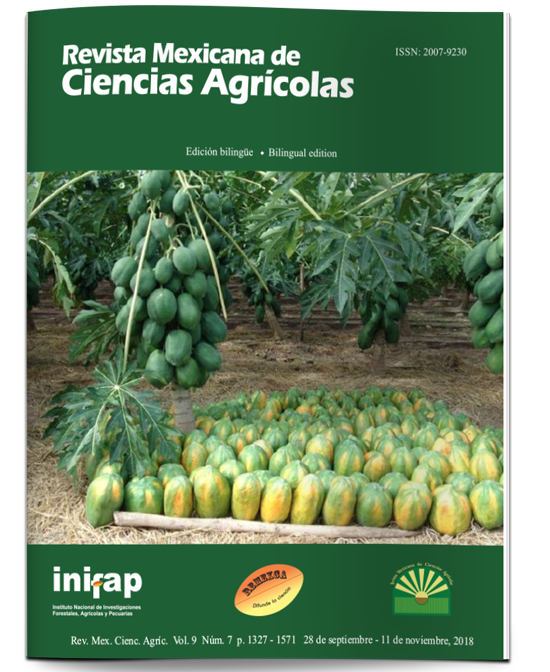Venado H74: early corn hybrid for rainfed and irrigated areas of the Central Plateau of Mexico
DOI:
https://doi.org/10.29312/remexca.v9i7.1678Keywords:
Zea mays L., early maturity, semicrystalline white grain, trilinear hybridAbstract
Due to the climate change that manifests itself in irregular distribution of rainfall less amount of this or its incidence in delayed time and higher temperature, the problem of lack of early maize hybrids arises, especially for regions of low and medium productive potential of the central table of Mexico, which cover 1 million 200 thousand hectares of cultivated area. The hybrid of early corn Venado H74 was generated to respond to these conditions of climate change, since it is an early-cycle trilinear hybrid with a very favorable performance response in regions with altitudes of 2 500 to 2 650 meters above sea level, where average temperatures prevail. 10.4 to 13.8 °C and rainfall levels of 482 to 852 mm, it is tolerant to drought in the vegetative and reproductive stages and performs well in conditions of low chemical fertilization. Its yield has a range of 2.3 to 12.6 t ha-1 which surpasses the 50% creole varieties and 20% commercial hybrids. It presents its period of heading between 96 and 109 days at altitudes of 2 500 and 2 600 m, respectively, where other hybrids and commercial varieties reach it between 110 and 115 days. It is resistant to the charcoal of the spike (Sphaceloteca reiliana) and to the rot of the ear (Fusarium spp.) and has the quality of nixtamalera-tortillera. Venado H74, is a trilinear hybrid whose female parent renders 7.5 t ha-1 in the high valleys, which gives it 25% more profitability in the production of registered and certified seed compared to other commercial corn hybrids. Its plant size facilitates intensive sowing with 70 thousand plants ha-1 and with planting to 100 thousand plants ha-1 ha under irrigation has shown yields of 14 t ha-1. The harvest can be done at 160 days with a moisture content in grain 25%, so the cob must undergo a drying process to reduce the moisture content of the grain to 14%. The main economic impact of Venado H74 is the difference of 3 to 4 t ha-1 over the yield of the creole variety, which represents 12 to 16 thousand pesos per hectare, which makes corn production profitable.
Downloads
Downloads
Published
How to Cite
Issue
Section
License
The authors who publish in Revista Mexicana de Ciencias Agrícolas accept the following conditions:
In accordance with copyright laws, Revista Mexicana de Ciencias Agrícolas recognizes and respects the authors’ moral right and ownership of property rights which will be transferred to the journal for dissemination in open access. Invariably, all the authors have to sign a letter of transfer of property rights and of originality of the article to Instituto Nacional de Investigaciones Forestales, Agrícolas y Pecuarias (INIFAP) [National Institute of Forestry, Agricultural and Livestock Research]. The author(s) must pay a fee for the reception of articles before proceeding to editorial review.
All the texts published by Revista Mexicana de Ciencias Agrícolas —with no exception— are distributed under a Creative Commons License Attribution-NonCommercial 4.0 International (CC BY-NC 4.0), which allows third parties to use the publication as long as the work’s authorship and its first publication in this journal are mentioned.
The author(s) can enter into independent and additional contractual agreements for the nonexclusive distribution of the version of the article published in Revista Mexicana de Ciencias Agrícolas (for example include it into an institutional repository or publish it in a book) as long as it is clearly and explicitly indicated that the work was published for the first time in Revista Mexicana de Ciencias Agrícolas.
For all the above, the authors shall send the Letter-transfer of Property Rights for the first publication duly filled in and signed by the author(s). This form must be sent as a PDF file to: revista_atm@yahoo.com.mx; cienciasagricola@inifap.gob.mx; remexca2017@gmail.
This work is licensed under a Creative Commons Attribution-Noncommercial 4.0 International license.



